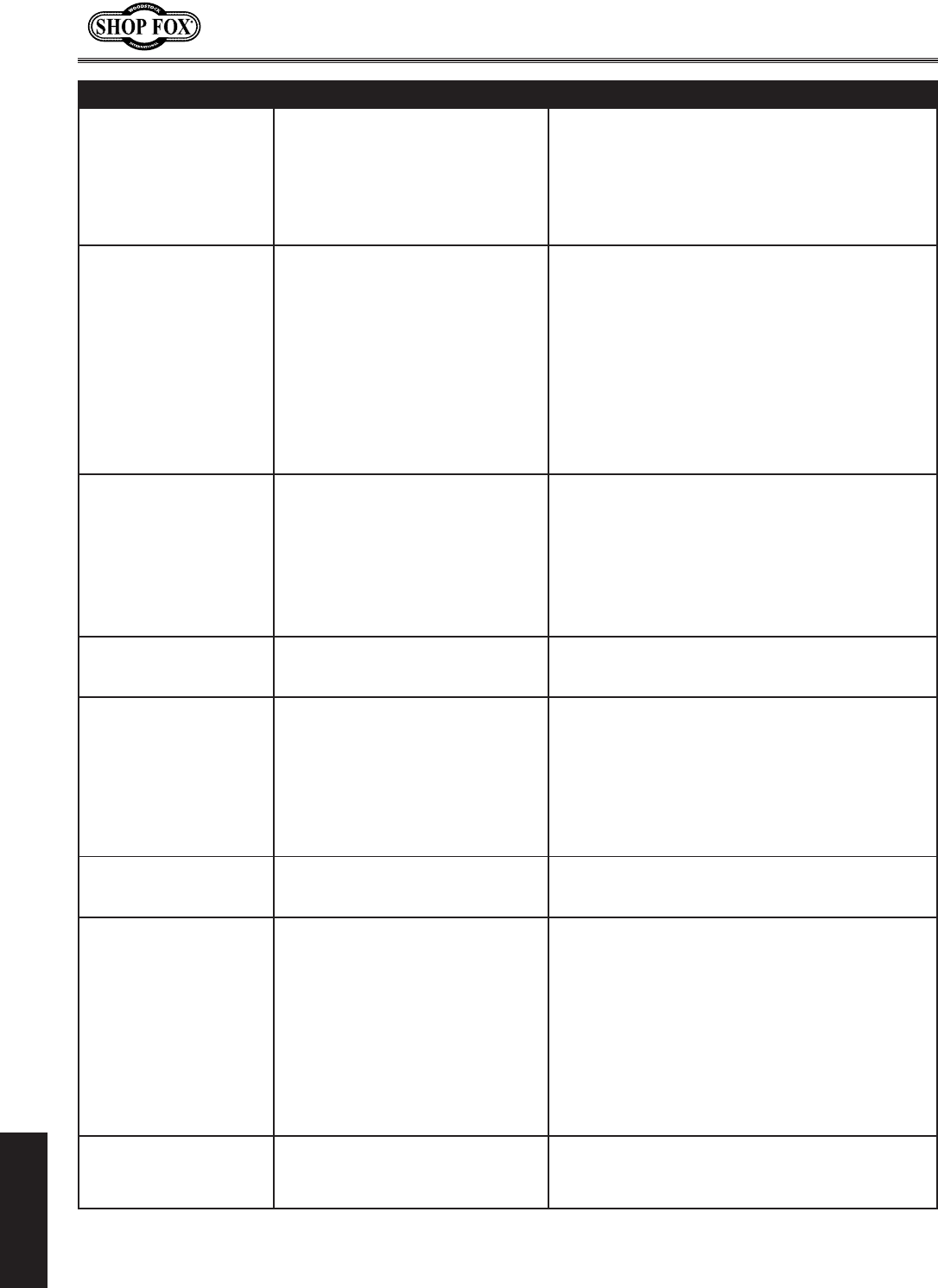International, Inc. Planer User Manual

-44-
N(/()Fne\ijDXelXcD]^%j`eZ\*&'0
G8IKJ
GIF9C<D GFJJ@9C<:8LJ< :FII<:K@M<8:K@FE
Excessive snipe (there is
a dip in the end of the
board that is uneven with
the rest of the cut).
1. One or both of the feed rollers are
set too low.
1. Adjust the feed rollers to the correct height (Page
21).
2. Feed roller springs are applying
too much roller pressure.
2. Reduce the feed roller spring tension (Page 21).
3. Workpiece is not supported as it
leaves the planer/moulder.
3. Hold the workpiece up slightly as it leaves the
outfeed end of the planer/moulder.
Workpiece stops/slows in
the middle of the cut.
1. Taking too heavy of a cut. 1. Raise headstock to take a lighter cut.
2. One or both of the feed rollers are
adjusted too high and workpiece
slips.
2. Lower the feed rollers (Page 21) to what is
specified in manual.
3. Feed roller spring tension is too
light.
3. Increase the feed roller spring tension (Page 21).
4. Guide or fence is interfering with
the workpiece travel.
4. Adjust guides or fence for adequate support
without workpiece interference.
5. Pitch and glue build-up on planer
components.
5. Clean internal cutterhead components with a
pitch/resin dissolving solvent.
Chipping (consistent
pattern).
1. Knots or conflicting grain direction
in wood.
1. Inspect workpiece for knots and grain direction;
only process clean stock (Page 23).
2. Nicked or chipped knife. 2. Replace the affected knife, or have it sharpened.
3. Feeding workpiece too fast. 3. Slow down the feed rate.
4. Taking too deep of a cut. 4. Take a smaller depth of cut. Always reduce cutting
depth when surface planing or working with hard
woods (Page 23).
Chipping (inconsistent
pattern).
1. Chips are not being properly
expelled from the cutterhead
area.
1. Provide a minimum of 400 CFM at the port, and
keep dust collector and ducting free of clogs and
restrictions.
Fuzzy grain. 1. Wood may have high moisture
content or surface wetness.
1. Check moisture content and allow to dry if
moisture is too high (Page 23).
2. Dull knives. 2. Replace the knives or have them professionally
sharpened.
3. Chips are not being properly
expelled from the cutterhead
area.
3. Provide a minimum of 400 CFM at the port, and
keep dust collector and ducting free of clogs and
restrictions.
Long lines or ridges that
run the length of the
board.
1. Nicked or chipped knife(s). 1. Replace or sharpen the knives.
Uneven knife marks, wavy
surface, or chatter marks
across the face of the
board.
1. Moulding knife is installed at
outboard side of cutterhead.
1. Install moulding knife at the inboard side of
cutterhead.
2. Feeding workpiece too fast. 2. Slow down the feed rate.
3. Feed roller spring tension is too
light.
3. Increase the feed roller spring tension (Page 21).
4. Knives are loose. 4. Remove the knives, clean knife mounting surfaces,
and reinstall knives.
5. Headstock is loose. 5. Adjust headstock gib (Page 38), and be sure to use
headstock lock lever.
6. Worn cutterhead bearings. 6. Replace cutterhead bearings.
Glossy surface. 1. Knives are dull. 1. Replace or sharpen the knives.
2. Feed rate too slow. 2. Increase the feed rate.
3. Cutting depth too shallow. 3. Increase the depth of cut.










